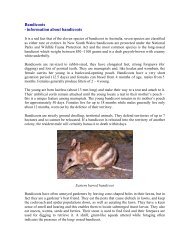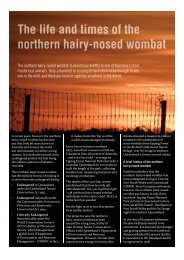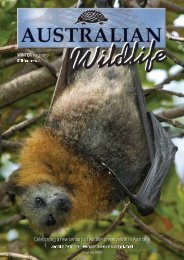Wildlife Preservation Autumn 2012.indd - Wildlife Protection Society ...
Wildlife Preservation Autumn 2012.indd - Wildlife Protection Society ...
Wildlife Preservation Autumn 2012.indd - Wildlife Protection Society ...
Create successful ePaper yourself
Turn your PDF publications into a flip-book with our unique Google optimized e-Paper software.
Suzanne Medway receiving her award from NRMA President<br />
Wendy Machin, accompanied by Patrick Medway<br />
Serventy Conservation Medal for 2010<br />
This special award was inaugurated in 1999 to<br />
commemorate the wonderful conservation work by<br />
the members of the Serventy family: Dr Vin Serventy,<br />
his brother Dr Dominic Serventy and his sister Lucy.<br />
Each member of the family has given a lifetime of<br />
commitment to the conservation and preservation of<br />
Australian wildlife.<br />
The Serventy Conservation Medal for 2010 was awarded<br />
to Helen George of Kangaroo Valley. Few people have<br />
devoted over 45 years of their lives to conservation.<br />
However, that is the achievement of the winner of our<br />
Serventy Medal for 2010, Helen George. Helen was<br />
one of the people who contributed to the forming of<br />
the <strong>Wildlife</strong> Information and Rescue Service (WIRES)<br />
and since that time she has been active in educating<br />
wildlife carers how to be responsible for the animals<br />
which come into their care. Helen is reputed to be the<br />
rst person to successfully raise an orphaned greyheaded<br />
ying fox to maturity. This occurred in 1978<br />
and the ying fox was less than 24 hours old when<br />
Helen received him. Much of his life was spent as an<br />
education animal, living for almost 23 years. Helen<br />
developed considerable expertise in this area and, in<br />
1987, was awarded the Medal of the Order of Australia<br />
(OAM) for her services to conservation, principally for<br />
her work on the plight of the grey-headed ying fox.<br />
She was one of the key advocates for getting the NSW<br />
Government to place them on the protected list. She<br />
is a scientic member of the Royal Zoological <strong>Society</strong><br />
of NSW. Helen shares her knowledge freely and,<br />
although she has no formal academic qualications,<br />
is often called on to talk to a variety of organisations,<br />
students and tertiary institutions. With such a length<br />
of experience, her knowledge is naturally not conned<br />
to ying foxes. She is a keen observer and recorder<br />
of data and rigorously pursues scientic principles.<br />
She is hoping to soon publish a book on the care of<br />
macropods which is eagerly awaited both by carers and<br />
veterinary scientists and students. It is a pleasure to<br />
have Helen’s name added to the list of Serventy Medal<br />
winners.<br />
Helen George holding the Serventy Conservation Medal<br />
Community <strong>Wildlife</strong> Conservation Award<br />
for 2010<br />
The Community <strong>Wildlife</strong> Conservation Award is<br />
made each year to recognise organisations which<br />
make a signicant contribution to the preservation of<br />
Australian wildlife.<br />
The Community <strong>Wildlife</strong> Conservation Award<br />
for 2010 was awarded to the Wombat Awareness<br />
Organisation of South Australia. The southern hairy<br />
nose wombat is the emblem of South Australia, yet<br />
landholders easily obtain permits to cull them. Often<br />
this is done in inhumane ways, while the species is in<br />
decline. The Wombat Awareness Organisation (WAO),<br />
led by Brigitte Stevens, has for many years been ghting<br />
to educate the community of South Australia that<br />
current practices risk the eventual extinction of the<br />
species. WAO has spent many hours of its members’<br />
time and considerable money on rescuing injured<br />
animals as well as negotiating with pastoralists over<br />
ways to live harmoniously with wombats. WAO has also<br />
conducted considerable research into sarcoptic mange,<br />
a deadly disease which threatens to ravage populations<br />
of the animal. WAO also has been raising money to<br />
purchase Portee Station in South Australia as a refuge<br />
for wombats as well as a place for scientic study<br />
into mange and other threats to wombat existence.<br />
Moreover, Portee Station will also be a refuge for other<br />
wildlife species, including 133 species of birds. WAO is<br />
Brigitte Stevens of the Wombat Awareness Organisation<br />
22 Australian <strong>Wildlife</strong> Vol 2 - <strong>Autumn</strong> 2012





